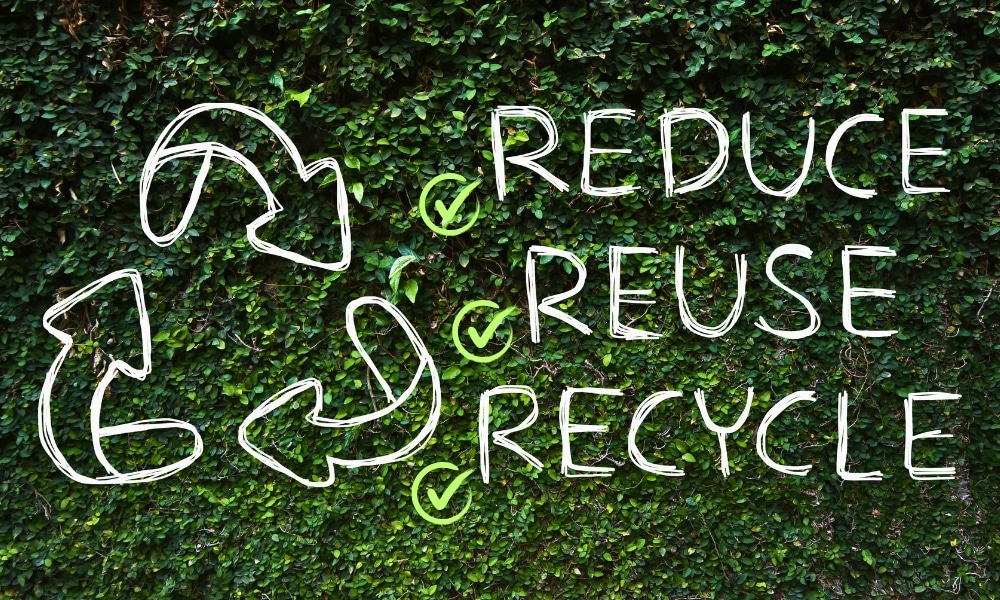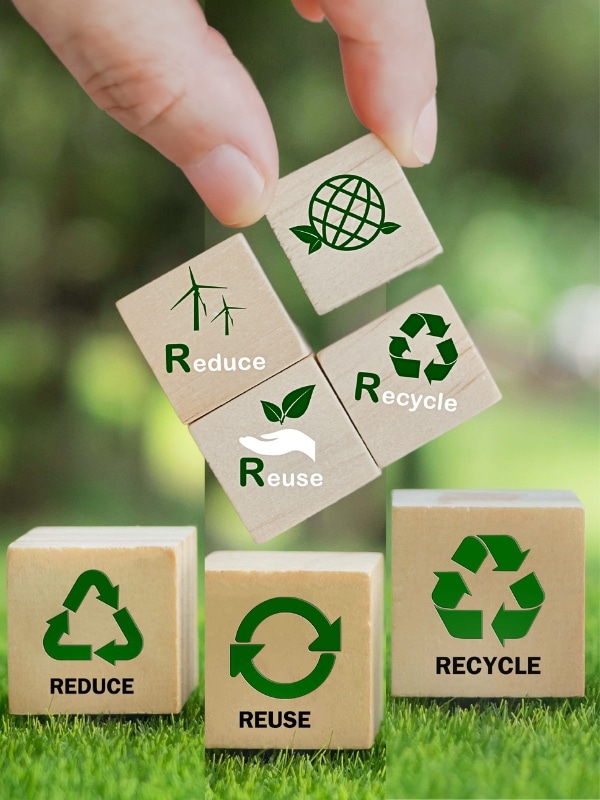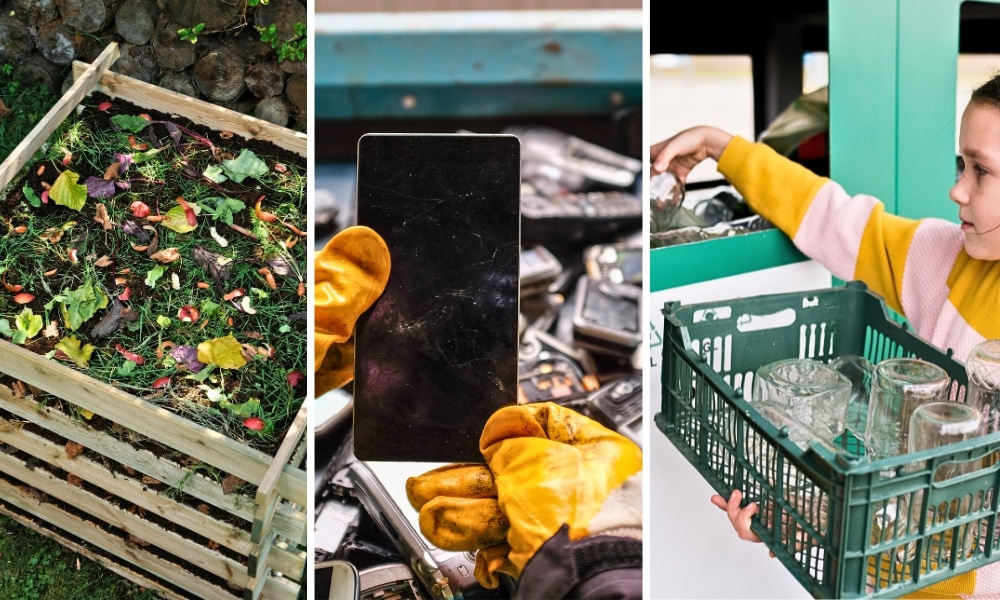Australia, a land of stunning natural beauty, faces increasing environmental challenges. From the Great Barrier Reef to the vast outback, our ecosystems are under pressure from climate change, pollution, and unsustainable resource consumption.
A crucial part of addressing these challenges lies in embracing the principles of reduce, reuse, and recycle. When implemented on a large scale, these three simple actions profoundly impact our environment: conserving resources, minimising pollution, and building a more sustainable future.

On this page
Let’s explore how we can all contribute to a healthier planet by actively reducing, reusing, and recycling. Discover the benefits and join Energy Matters in making a real difference – start today!
Join Energy Matters in advocating for a cleaner, more sustainable Australia. Energy Matters is here to guide you every step of the way. Energy Matters is one of Australia’s most trusted solar quotes due to our high customer satisfaction and industry recommendations. Our team of solar experts can help you get up to 3 FREE solar quotes from pre-qualified and vetted solar firms in your area.
Environmental benefits of reducing, reusing, and recycling
Australia’s commitment to environmental sustainability is exemplified through reducing, reusing, and recycling. These practices conserve resources and mitigate environmental impacts, contributing to a greener future
The power of reduction: Preventing waste at the source
The first and arguably most important step in the waste hierarchy is reduction. Reducing waste means preventing it from being created in the first place. This involves conscious choices to consume less, buy products with minimal packaging, and avoid single-use items. The benefits of reducing waste are numerous:
Conserving natural resources: Manufacturing products requires vast raw materials, energy, and water. Reducing our consumption reduces the demand for these resources, preserving forests, minerals, and water supplies.
Minimising pollution: Every stage of a product’s lifecycle, from resource extraction to manufacturing and disposal, generates pollution. Reducing consumption lessens this pollution burden, protecting our air, water, and land.
Reducing greenhouse gas emissions: Manufacturing, transporting, and disposing of goods contribute significantly to greenhouse gas emissions. Reducing consumption helps mitigate climate change by lowering these emissions.
Saving money: Buying less saves money. By being mindful of our consumption habits, we can reduce spending and live more sustainably.
Practical waste reduction tips for individuals include

Implementing the 3Rs: Reduce, Reuse, and Recycle: Embracing the principles of reduce, reuse, and recycle benefits the environment and conserves resources. For instance, reducing single-use plastics, reusing containers, and recycling paper products can significantly decrease household waste.
Choosing products with minimal packaging: Opt for products with less packaging or packaging made from recycled materials.
Bringing your bags: Avoid single-use plastic bags by bringing your reusable bags when shopping.
Saying no to single-use items: Refuse plastics like straws, coffee cups, and cutlery.
Composting organic waste: Composting food scraps and garden waste reduces landfill use and produces nutrient-rich soil for gardening. This practice supports eco-friendly waste management by returning valuable nutrients to the earth.
Planning meals: Reduce food waste by carefully planning meals and shopping lists.
Buying in bulk: Reduce packaging waste by purchasing items in bulk whenever possible.
Repairing instead of replacing: Extend the life of your belongings by fixing them instead of buying new ones.
Responsible e-waste disposal: Proper electronic waste disposal prevents hazardous materials from harming the environment. Utilising e-waste recycling programs ensures that valuable components are recovered and repurposed.
The art of reuse: Giving items a second life
Reusing involves finding a new purpose for items that would otherwise be discarded. This can range from repurposing old clothes to using glass jars for storage. The benefits of reuse are similar to those of reduction:
- Conserving resources: Reusing items reduces the need to extract and process new raw materials.
- Minimising waste: Reusing diverts items from landfills, reducing the volume of garbage.
- Reducing pollution: Reusing lessens the pollution caused by manufacturing and transporting new products.
- Saving money: Reusing items can save money when purchasing new goods.
Examples of reuse in action:
- Using glass jars for storage: Instead of buying new containers, reuse glass jars for storing food or other items.
- Repurposing old clothes: Turn old t-shirts into cleaning rags or use fabric scraps for craft projects.
- Composting food scraps: Composting food scraps reduces waste and creates nutrient-rich soil for gardening.
- Donating unwanted items: Donate unwanted clothes, furniture, and other items to charity instead of throwing them away.

Challenges and opportunities
Contamination in recycling streams
Proper waste sorting remains challenging, with contaminants like plastic bags and food waste compromising recycling efficiency. Educational initiatives are essential to inform the public about correct recycling practices.
Advancements in recycling technologies
Investing in innovative recycling technologies, such as advanced e-waste processing facilities, can enhance resource recovery rates and reduce environmental impacts. For example, companies like Fliptech are leading in e-waste recycling, refurbishing electronics and extracting valuable materials.
Government policies and initiatives
- National Waste Policy Action Plan
Australia’s National Waste Policy Action Plan outlines targets to reduce total waste generation by 10% per person and achieve an 80% average resource recovery rate by 2030. These goals demonstrate a strong commitment to sustainable waste management.
- Circular Economy Framework
The Circular Economy Framework aims to double Australia’s circularity rate, adding $26 billion to the economy and diverting 26 million tonnes of waste from landfills each year. This initiative focuses on enhancing material reuse, repair, and recycling to reduce environmental harm while boosting economic growth.
Did you know Energy Matters is Australia’s largest renewable news, blog and educational resource? Subscribe to Energy Matters’ weekly newsletter and keep updated even with incentives, rebates and recommended solar product offers.
The importance of recycling: Turning waste into resources
Recycling involves processing waste materials into new products. This process diverts materials from landfills and conserves valuable resources. The benefits of recycling are substantial:
- Conserving natural resources: Recycling reduces the need to extract virgin materials, preserving forests, minerals, and water supplies.
- Reducing landfill space: Recycling diverts waste from landfills, extending their lifespan and reducing the need for new landfills.
- Reducing pollution: Recycling often requires less energy than producing new products from raw materials, reducing pollution and greenhouse gas emissions.
- Creating jobs: The recycling industry creates jobs in collection, processing, and manufacturing.
Australia has made significant progress in recycling, but there’s always room for improvement. Current recycling rates for various materials vary, and contamination remains a challenge. Eco-friendly waste management practices are crucial for maximising the effectiveness of recycling programs.
Key aspects of effective recycling:
- Understanding local guidelines: Familiarise yourself with your local council’s recycling guidelines to ensure you are sorting your waste correctly.
- Cleaning recyclables: Clean recyclable items before placing them in the recycling bin to avoid contamination.
- Avoid contamination: Contamination can disrupt recycling, so keeping non-recyclable items out of the recycling bin is essential.
- Supporting businesses that use recycled materials: Choose products made from recycled materials to close the loop and support the recycling industry.
Waste reduction tips for communities and businesses:
- Implementing comprehensive recycling programs: Businesses and communities can implement effective recycling programs to divert waste from landfills.
- Promoting waste reduction initiatives: Encourage waste reduction through educational campaigns and incentives.
- Supporting sustainable procurement practices: Businesses can purchase products made from recycled materials and with minimal packaging.
- Investing in infrastructure for waste management: Governments can invest in infrastructure for recycling and composting to support eco-friendly waste management.
Sources: How we manage waste l Australia’s Circular Economy Framework – Department of Climate Change, Energy, the Environment and Water; Eco-Friendly Waste Management Practices – AllMetro Bins; Eco-friendly Strategies for Affordable Waste – Sustainable Living Guide
Take the next step towards a sustainable future
Reducing, reusing, and recycling are essential for building a sustainable future for Australia. By embracing these principles, we can conserve valuable resources, minimise pollution, and protect our unique environment. While progress has been made, continuous effort and innovation are needed to improve waste management practices further. Every individual, business, and community has a role in this effort.
Energy Matters urges you to take action today! Embrace the power of reduce, reuse, recycle, and become a champion for sustainable living. We can create a cleaner, healthier, and more sustainable Australia for future generations.
Upgrade your solar system without sending your old solar panels to landfill
If you upgrade your solar system, Second Life Solar will pay to remove your old panels. We are pleased to offer current solar consumers an alternative thanks to our partnerships with the CSIRO, the NSW Environment Protection Authority, and Energy Matters.









































